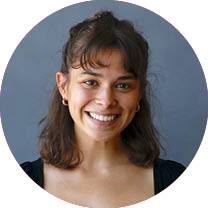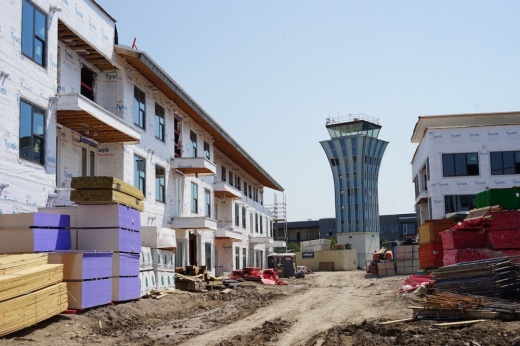The 700-acre stretch of land in Northeast Austin has been transformed from the Robert Mueller Municipal Airport to an eco-friendly development with dozens of locally owned restaurants and shops, affordable housing, an H-E-B, the Dell Children’s Medical Center of Central Texas, Austin Energy’s headquarters and a popular Sunday farmers market that brings in hundreds of residents from across town.
“It accomplishes one of the main purposes, which is to enable folks who might not have it all together to buy their first home. It makes it possible, cost wise, to do that,” said Suzanne O’Malley, who owns an affordable unit. “[Residents] enjoy the social aspect. They enjoy living near one another. They enjoy the activity on the street and outside.”
With a handful of parcels left for development, the vast majority of Mueller’s development is slated for completion by the end of 2024, according to Mueller’s master developer Catellus Development Corporation.
“It’s been extraordinarily successful. We get people from all over the country, probably around the world, who’ve studied the program,” Catellus President Greg Weaver said.
While Mueller has been hailed by city leaders as an example for what affordable housing can look like in Austin, replicating it can be a difficult and costly process, and Mueller itself has room to improve its affordability for residents.
How we got here
As Austin’s population grew and the Mueller airport aged, a group of residents known as Citizens for Airport Relocation, or CARE, began advocating in the early 1980s to move the airport farther from the city center, creating an opportunity to turn mostly undeveloped land into a neighborhood with affordable housing for those who earn 80% or less of Austin’s median family income as well as businesses, restaurants and ample green space.
“The airport didn’t close until the late ’90s. But [CARE] had a vision of what they wanted, and they wanted pedestrian friendly, bike friendly, and open space and affordable housing,” Weaver said.
Austin’s land development code requires most single-family houses to be on a minimum 5,750-square-foot lot. However, Mueller has homes on plots as small at 600 square feet, a design choice that was made possible through a planned unit development, or PUD.
Austin landowners can create a PUD when developing a site 10 acres or greater, and this gives developers more freedom when building homes, roads and other infrastructure in a project. Mueller’s PUD allowed the development to have smaller houses, such as townhouses and row homes, that are typically less expensive to build. The PUD also made room for Foundation Communities, an affordable housing nonprofit, to build several 600-square-foot units for people exiting homelessness.
Weaver said Mueller has achieved or surpassed its goals that were outlined in the original master plan, including providing 25% affordable housing and making every building Leadership in Energy and Environmental Design certified—which means they use less water compared to non-LEED buildings and use renewable energy. The development doubled its goal to fill at least 30% of its retail space with local businesses, and every resident lives within 600 feet of a green space.
Mueller also met one of its goals to make the affordable and market-rate homes look indistinguishable from one another. Weaver said Mueller achieved that in part by building creative housing types, such as one house that looks like a larger single-family home on the outside but actually houses several separate units.
“I am most grateful to have qualified for an affordable home because I wouldn’t have been able to move to Austin otherwise,” said Cristina Meiring, a recent owner of an affordable home in Mueller. “I could not drive around and tell you what homes are affordable and which ones are not.”
Affordable housing setbacks
While Mueller provides housing for people making around 80% MFI, other costs, such as homeowners association fees and general upkeep, are still burdening some.
“I am very concerned about rising HOA fees and how that impacts affordable homeownership,” Meiring said.
Meiring is a retired teacher, but she went back to work part time as a substitute in Austin ISD to supplement her budget.
Meiring said she has written letters to the city about lowering HOA fees for affordable home owners and hasn’t received a response.
Some Mueller residents have also raised concerns with the development’s long-term affordability.
Mueller has several mechanisms in place that protect its long-term affordability. The majority of affordable homes have a 2% appreciation cap that prevents them from being resold at market price. The development also has a partnership with The Mueller Foundation, a nonprofit that buys affordable homes back from its owners and resells them at the same affordable price, Weaver said.
The Robert Mueller Municipal Airport Plan Implementation Advisory Commission unanimously approved a motion in February asking City Council to look into Mueller’s long-term affordability before Catellus’ agreement expires in December 2024.
Despite Mueller’s success, the development’s roughly 1,700 affordable housing units barely make a dent in the city’s overall goal to add 60,000 affordable housing units by 2028.
Replicating affordable housing sites similar to Mueller can be a difficult, costly process, Austin Housing Coalition Chair Abby Tatkow said. Austin has limited undeveloped land that can be used for a master-planned community, and bringing affordable housing to already-developed neighborhoods brings on additional challenges, she said.
“We have a very robust notification system that [notifies residents] that development is happening in their neighborhood, but it also gives a lot of power to the individual to protest zoning changes that can allow more dense or affordable housing,” Tatkow said.
Building affordable housing on undeveloped land in Austin’s outskirts has its setbacks as well, Tatkow said, as those areas often lack access to schools, hospitals and grocery stores.
What’s next
While building affordable housing presents challenges in Austin, a proposal inspired by Mueller from Council Member Leslie Pool aims to add more affordable developments in the city.
The proposal would allow more homes to be built on single-family properties citywide to bring what Pool called “gentle” density to existing neighborhoods.
Separately, Austin is exploring fewer notifications when housing projects are being built in neighborhoods in line with other peer cities. The issue of resident notification and protests over new development ended the city’s last attempt to update its land code, seen by some as a win for locals’ property rights and by others as an impediment for building more housing.
Further, a new master-planned community in Colony Park resembling Mueller is going through the initial planning stages. The project is on 208 acres of city-owned land in Northeast Austin and will be developed by Catellus.
The project is expected to deliver 1,072 single-family homes and 831 multifamily apartments, 20% of which will be reserved as affordable housing.
"But if more Muellers are wanted and more communities like that with the parks and the bikes and the trails and housing and everything else, the code needs to be fixed," Weaver said.





